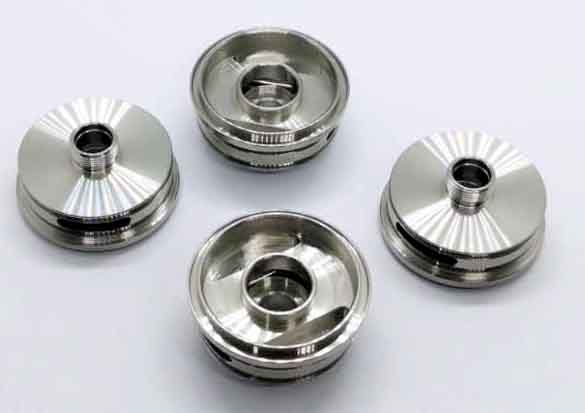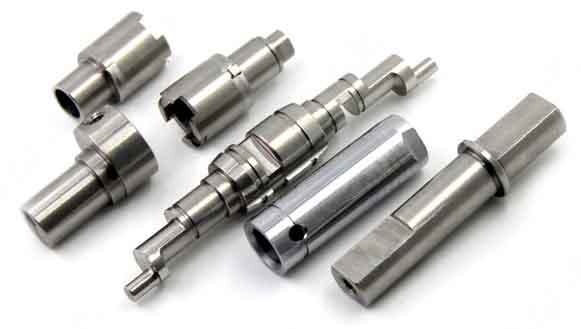This article analyzes the process settings for turning hardened steel, high temperature alloy, Lega di titanio, chilled cast iron, and thermal spray material parts. And the characteristics of these difficult-to-cut materials, cutting quantities, turning fluids, and turning tools.
Turning technology of hardened steel
1. Turning of hardened steel:
① Cutting characteristics of hardened steel:
1) High hardness: HRC45-70.
2) Elevata fragilità.
3) Molta forza: σb = 2100~2600 MPa, di cui si tratta 4 volte quello di 45 acciaio.
4) Grande forza di taglio: La forza di taglio unitaria Kc è 4500 MPa, che è 2.5 volte quello di 45 acciaio.
5) Temperatura di taglio elevata: la sua conduttività termica è 1/7 Di 45 acciaio.

Turning technology of hardened steel
② Utensile da tornio e quantità di taglio di acciaio temprato:
1) Materiali degli strumenti: PCBN, ceramica, carburo cementato (600, 610, YS8, YT05, 758, 813), eccetera.
2) Parametri della geometria dell'utensile: γ0=0~-10°, durezza del pezzo e taglio continuo γ0=-10~-30°, α0=8~10°, κr=30~60°, λs=0~-3° .
3) Importo del taglio: carburo cementato Vc=30~50m/min; Utensile in ceramica Vc=60~120m/min; Utensile PCBN Vc=100~200 m/min, Vc lo è 1/2 di cui sopra durante la svolta intermittente, e αp e f lo sono 1/2 di acciaio generale.
Nota: Generalmente, la resistenza al calore dell'acciaio bonificato è 200~400℃, and its hardness decreases with increasing temperature. The heat resistance of tool materials (hard alloys, ceramica, PCBN) are respectively 800~1000℃, 1200℃, 1400~1500℃, using this feature, in continuous cutting, Vc cannot be selected too low; When drilling, Vc should be reasonable, and the tool should be retracted; During continuous cutting, f should be small, κr should be appropriately reduced, γε increased, and λs should be negative.
Turning technology of superalloy

Turning technology of superalloy
2. Turning of superalloy
Because the high-temperature alloy contains many high melting point alloying elements Fe, Ti, Cr, Ni, V, W, Mo and so on. This element and other alloying elements form an austenitic alloy with high purity and dense structure. The contained elements and the non-metallic elements C, B, N, eccetera. form metal and non-metal compounds with high hardness, low specific gravity, and high melting point. Make other machinability very poor. Its relative turning workability is only 5-20% Di 45 acciaio.
① Turning characteristics of superalloy:
1) Grande forza di taglio: 2 A 3 times larger than cutting general steel.
2) Temperatura di taglio elevata: 50% higher than cutting 45 acciaio.
3) Severe work hardening: the hardness of the cutting surface and the machined surface is 50-100% higher than that of the matrix.
4) Tools are easy to wear: adesione, diffusion, ossidazione, and groove wear are easy to occur.
②Materials for turning tools of high-temperature alloys:
1) High-speed steel: High-speed steel containing high vanadium, high carbon and aluminum should be used.
2) Cemented carbide: fine and ultrafine particles of YG should be used
③ Geometric parameters of turning tools for high-temperature alloys:
Deformed superalloy: γ0=10°, cast superalloy: γ0=0°, generally do not take negative chamfering. α0=10~15°, tornitura di sgrossatura λs =-10°, rotazione fine λs=0~3°, κr=45~75°.
④ Quantità di superlega tornita:
1) Taglierina in acciaio ad alta velocità: Vc=3~8m/min.
2) Strumento in carburo: Vc=10~60 m/min. Deformed superalloy: Vc=40~60m/min. Fusione di lega ad alta temperatura: Vc=7~10m/min. αp e f>0.1mm.
⑤ Fluido da taglio per leghe ad alta temperatura: lo stesso dell'acciaio inossidabile.
⑥ Foratura di leghe ad alta temperatura: Per quanto possibile, utilizzare punte al carburo o punte di tipo S e per fori poco profondi; Per esempio, quando si utilizza un trapano in acciaio ad alta velocità, aumentare la dimensione di 2 fili, macinare α0 e b, Vc lo è 3 m/min, e f è 0,2~0,3 mm/giro; La punta del trapano dovrebbe essere affilata, e lo standard per la schiettezza è 1/2 A 1/3 di quello dell'acciaio generale. È meglio utilizzare l'alimentazione automatica, non fermarsi sulla superficie di taglio.

Tecnologia di tornitura di parti in titanio
Tecnologia di tornitura di parti in titanio
3. Turning of titanium alloy:
Titanium alloy is a new metal developed in recent decades. Because of its high specific strength (σb/ρ=1680/4.5=373, 4.5 volte quello di 45 acciaio), high thermal strength (long-term work at 500℃), good corrosion resistance, and excellent low temperature performance, it is used in aerospace, chemical engineering , Medical treatment, eccetera.
① Cutting characteristics of titanium:
1) The cutting temperature of titanium is high: under the same cutting conditions, it is twice as high as cutting 45 acciaio.
2) Titanium has a great affinity and serious bonding, which will cause bonding at high temperatures.
3) Titanium has high chemical activity: under high temperature cutting conditions, it reacts with O, N, H, C in the air to form a hard skin layer of TiO2, TiN, TiH, eccetera., which brings difficulties to cutting.
② Materiali per utensili per la tornitura del titanio:
1) High-speed steel: Oltre al normale acciaio rapido, è meglio usare un alto contenuto di vanadio, ad alto contenuto di cobalto, e acciaio rapido contenente alluminio.
2) Cemented carbide: YG8, YG6X, YG6A, 813, 643, YS27, YD15.3) PCD, Diamante naturale PCBN.
③ Parametri della geometria dell'utensile: γ0=5~15°, α0≥15°.
④ Quantità di titanio tornita:
1) Taglierina in acciaio ad alta velocità: Vc=8~12 m/min.
2) Utensili in metallo duro: Vc=15~60 m/min.
3) PCD, Utensili in diamante naturale PCBN: taglio ad umido Vc=200 m/min
Taglio a secco Vc=100 m/min, P>0.05mm, F>0.05mm/giro.
⑤ Fluido da taglio al titanio: Per uno vengono utilizzate l'emulsione e l'emulsione a pressione estrema. Per la finitura viene utilizzato olio da taglio a pressione estrema.
⑥ Nota per la tornitura del titanio:
Quando si gira un albero sottile (asta), la punta livellata e il nylon devono essere utilizzati come supporto per artigli del portautensili e del telaio centrale; Durante l'alesatura, utilizzare l'olio di ricino 60% + cherosene 40% as cutting fluid; When tapping, appropriately increase the diameter of the bottom hole.
4. Turning of chilled cast iron:
The surface layer of the cast iron is white mouthed, and the hardness can reach about HRC60; The unit cutting force K c can reach 3000 MPa, che è 1.5 times that of cutting 45 acciaio; The cutting force is concentrated near the cutting edge, and there are pores and sand in the machining, which can easily damage the tool during cutting;
Its brittleness is large, and the phenomenon of edge chipping and slag falling will occur during cutting.
① Tool material for turning cast iron:
1) Cemented carbide: a cemented carbide with high hardness and bending strength should be selected. Such as: YS2, YS8, YS10, 600, 610, 726.
2) Ceramics: SG4, AT6, SM, FT80, FT85.
3) PCBN: used for fine turning.
② The geometric parameters of the tool for turning cast iron: 1) Carbide: γ0=0~-5°, α0=5~10°, κr≤45°(κr=45°), λs =-5~一10°, γε =0.5~1 mm;
③ The amount of cutting cast iron:
1) Strumento in carburo: rough machining Vc=7~10m/min, αp=5~10mm, f=0.5~1.5mm/r. Finishing: Vc=15~20m/min, αp=0.5~2mm, f=0.3~0.5mm/r.
2) Ceramic tools: Vc=40~50m/min, αp=0.5~2mm, f=0.3~0.6mm/r.
3) PCBN cutter: Vc=60~70m/min, αp=0.5~2mm, f=0.1~0.3mm/r.
5. Turning of thermal spraying (saldatura) materiali:
Thermal spraying materials are mostly multi-component high-strength alloys. After high temperature and high speed spraying on the surface of the workpiece, the hardness, resistenza alla corrosione, wear resistance and heat resistance of the surface of the workpiece are greatly improved, and it is widely used. The hardness of the copper-based and iron-based powder spray coating is easier to cut. The hardness of the cobalt-based and nickel-based powder spray coating is >HRC50, which is difficult to cut. Cobalt-clad WC, nickel-clad WC, and nickel-clad Al2O3 spray coatings have hardness> HRC65, which is the most difficult to cut.
① Tool materials for turning thermal spraying materials:
1) Cemented carbide: durezza>HRC45, using YG, YW cemented carbide;
Hardness, using 600, 610, 726, 767, YD05, YC12, YS2, YS8;
Hardness>HRC65, use YG3X, YD05, YC09, YC12, YS8, 600, 610.
2) Ceramic cutter: 3) PCBN
② The geometric parameters of the tool when turning thermal spray materials: γ0=0~-5°, α0=8~12°, κr≤45°.
③ The amount of cutting thermal spraying material: cemented carbide Vc=6~40m/min;
Ceramic cutter Vc=18~80m/min;
PCBN tool: Vc=24~160m/min. αp=0.15~0.6mm; f=0.1~1mm/r.
 English
English العربية
العربية 中文(漢字)
中文(漢字) Čeština
Čeština Dansk
Dansk Nederlands
Nederlands Suomi
Suomi Français
Français Deutsch
Deutsch Italiano
Italiano 日本語
日本語 ಕನ್ನಡ
ಕನ್ನಡ 한국어
한국어 Português
Português Русский
Русский Slovenčina
Slovenčina Español
Español Svenska
Svenska Türkçe
Türkçe

